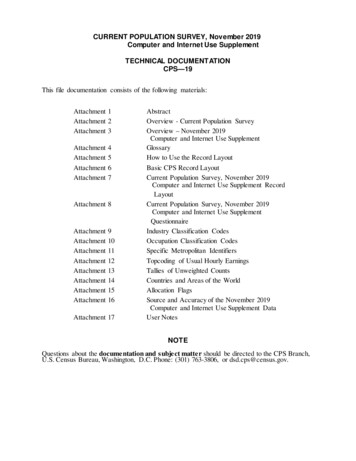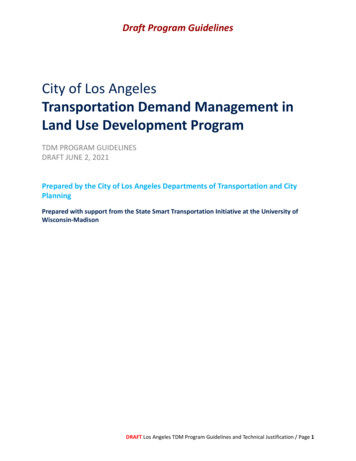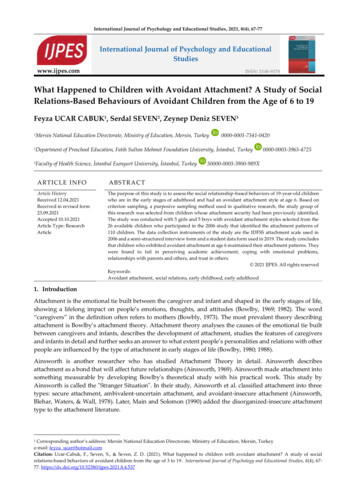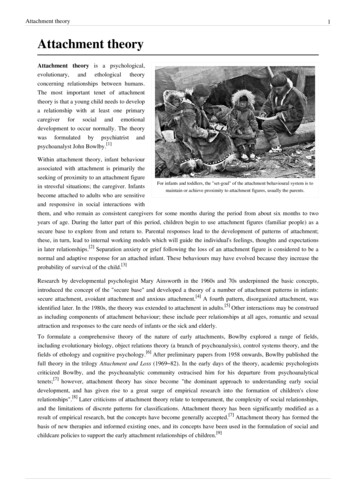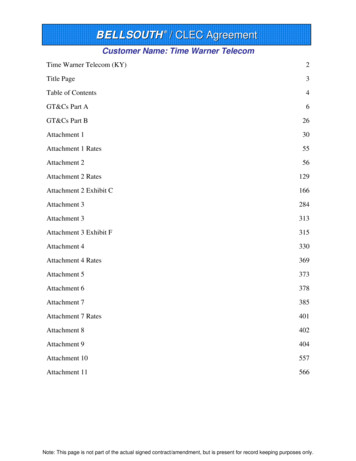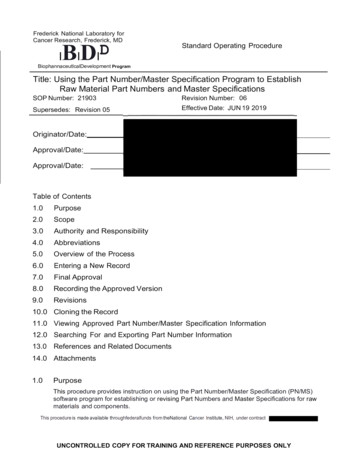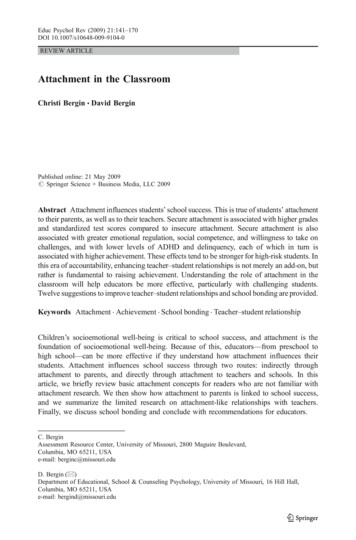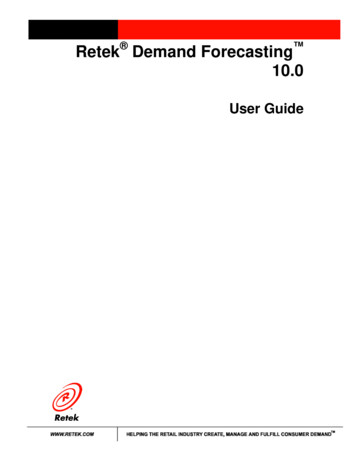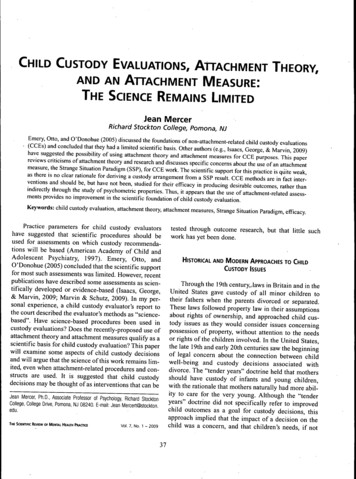
Transcription
ATTACHMENT GTRANSPORTATION DEMAND MANAGEMENT STRATEGIES INLA VMT CALCULATORIntroductionThis document provides an overview of the Transportation Demand Management (TDM) strategies included in theCity of Los Angeles Department of Transportation Vehicle Miles Traveled (VMT) Calculator. The VMT Calculator is atool designed to measure whether a development project exceeds the VMT thresholds of the City of Los Angeles,based on the MXD methodology1 validated for City of Los Angeles conditions as documented in the City of LosAngeles VMT Calculator Documentation (Fehr & Peers, October 2017) and the potential VMT reductions availablefrom certain types of project site modifications, programming, and operational changes collectively known as TDMstrategies.The effectiveness of each of the 23 TDM strategies included in the VMT Calculator is based primarily on researchdocumented in the 2010 California Air Pollution Control Officers Association (CAPCOA) publication, QuantifyingGreenhouse Gas Mitigation Measures (CAPCOA, 2010). CAPCOA offers methodology based on preferred literature,along with methodology based on alternative literature, for each strategy. The strategies used in the VMTCalculator follow CAPCOA guidance by either directly applying the CAPCOA methodology, applying the alternativeliterature methodology, or adjusting the methodology offered by CAPCOA to account for local needs anddepartmental goals. Where more recent research (since 2010) or local empirical data are available, those methodshave been used in place of the methodology outlined by CAPCOA. The methodology is specified for each strategyin the pages that follow.The TDM strategies are individually described in this document, with individual levels of effectiveness identified.However, to ensure the effectiveness of TDM strategies is not overstated, the VMT reductions in the VMTCalculator are both dampened and capped.Dampening: Within each type of trip (home-based work trip starting at the home end, for example), amultiplicative dampening formula is applied. For example, if both Strategy A and Strategy B are applied, thecombined effectiveness is not A B, but rather 1-(1-A)*(1-B). This captures the reality that many people who wouldconsider using Strategy B overlap with the potential market for Strategy A, and would choose A or B for each trip,but not both A and B.Capping: For the full set of strategies selected across all trip types, a place-type limit, or cap, is applied. The placetype is a pre-defined category based on land use characteristics of the location where the project is sited. Fourplace-types, or travel behavior zones (TBZs), have been developed by the City: Urban, Compact Infill, SuburbanCenter, and Suburban. Consistent with CAPCOA, for urban locations, the maximum VMT reduction that can beachieved by combining TDM strategies is 75%. For compact infill locations, the maximum is 40%. For suburbancenter locations, the maximum is 20%, and for suburban locations the maximum is 15%. These maximums aredescribed and substantiated in CAPCOA. A map of the TBZ system is included in Figure 1.1The MXD methodology was originally developed by the U.S. Environmental Protection Agency to better estimate tripgeneration in urban areas considering a number of factors including the relative numbers of residents and jobs, the density ofdevelopment, the connectivity for walking or driving among different activities, the availability of transit, the number ofconvenient trip destinations within the immediate area, vehicle ownership, and household size.
Transportation Demand Management Strategies in LA VMT CalculatorNovember 2019In the pages that follow, the inputs required by the project applicant are highlighted in yellow. The other formulacomponents are either coefficients identified in the research and documented in CAPCOA or predefined quantitiesbased on the location of the project.FIGURE 1 TRAVEL BEHAVIOR ZONES2
Transportation Demand Management Strategies in LA VMT CalculatorNovember 2019Parking1. Reduce Parking Supply2. Unbundle Parking3. Parking Cash-Out4. Price Workplace Parking5. Residential Area Parking PermitsTransit1. Reduce Transit Headways2. Implement Neighborhood Shuttle3. Transit SubsidiesEducation & Encouragement1. Voluntary Travel Behavior Change Program2. Promotions & MarketingCommute Trip Reductions1. Required Commute Trip Reduction Program2. Alternative Work Schedules and Telecommute Program3. Employer Sponsored Vanpool or Shuttle4. Ride Share ProgramShared Mobility1. Car Share2. Bike Share3. School Carpool ProgramBicycle Infrastructure1. Implement/Improve On-Street Bicycle Facility2. Include Bike Parking per LAMC3. Include Secure Bike Parking and Showers per LAMCNeighborhood Infrastructure1. Traffic Calming Improvements2. Pedestrian Network Improvements3
Transportation Demand Management Strategies in LA VMT CalculatorNovember 2019Parking1. Reduce Parking SupplyThis strategy changes the on-site parking supply to provide less than the amount of vehicle parking required bydirect application of the Los Angeles Municipal Code (LAMC) without consideration of parking reductionmechanisms permitted in the code. Permitted reductions in parking supply could utilize parking reductionmechanisms such as TOC, Density Bonus, Bike Parking ordinance, or locating in an Enterprise Zone or Specific Planarea. Reductions in parking supply could also include reductions in parting requirements due to variances soughtby a project. This strategy is appropriate for use in all land-use contexts and all types of development, and appliesto all trip types.The maximum available VMT reduction from this strategy is 12.5%.The formula used to calculate the reduction in VMT as a result of this strategy is as follows:VMT Reduction [(Base City Code parking requirement – Actual parking provision)/Base City Codeparking requirement] x 0.5Inputs: Base city code parking requirements – enter the number of spaces required by direct application of the LAMunicipal Code without consideration of parking reduction mechanisms permitted in the code.Actual parking provision – enter the number of spaces that the project will be providing.The application and effectiveness of this strategy is based on research and methodology documented in the 2010California Air Pollution Control Officers Association publication, Quantifying Greenhouse Gas Mitigation Measures(CAPCOA), Strategy PDT-1. CAPCOA Strategy PDT-1 has been adjusted to reflect a change in parking provisioncompared to the City Code requirements, rather than the ITE Parking requirements as specified in CAPCOA.4
Transportation Demand Management Strategies in LA VMT CalculatorNovember 2019Parking2. Unbundle ParkingThis strategy unbundles the parking costs from the property costs, requiring those who wish to purchase parkingspaces to do so at an additional cost from the property cost. The strategy assumes the parking cost is set by theproject applicant, between 25 and 220 per month, and paid by the vehicle owners/drivers. This strategy isappropriate for residential developments in all land-use contexts, and applies to home-based trip types. Thisstrategy is appropriate only where residential parking permit zones are in place for residential neighborhoodsadjacent to the project or where street parking is metered, on-street parking supply is regulated by parkingmanagement strategies approved by LADOT, or heavily utilized as demonstrated through a parking analysisThe maximum available VMT reduction from this strategy is 26% of residential-based VMT, if implemented withresidential permit parking and priced on-street parking to limit spillover.The formula used to calculate the reduction in VMT as a result of this strategy is as follows:VMT Reduction (-0.4) x [(Monthly parking cost) x (12/ 4,000)]Inputs: Monthly parking cost – enter the monthly dollar amount cost of each parking space, between 25 and 220. If amount of each parking space cost to vehicle owners/drivers is greater than 220, maximumreduction will be calculated.The application and effectiveness of this strategy is based on research and methodology documented in the 2010California Air Pollution Control Officers Association publication, Quantifying Greenhouse Gas Mitigation Measures(CAPCOA), Strategy PDT-2.5
Transportation Demand Management Strategies in LA VMT CalculatorNovember 2019Parking3. Parking Cash-OutThis strategy requires employers to offer employees the opportunity to “cash-out” the monthly value of theircurrently-free or subsidized parking space. The project applicant determines an employee’s eligibility toparticipate. This strategy is appropriate for all land-use contexts and all types of development that haveemployment, and applies only to attraction-end trips originating at home and terminating at work. The strategydepends on parking that is unbundled from the commercial lease.The maximum available VMT reduction from this strategy is 7.7% of commute VMT.The formula used to calculate the reduction in VMT as a result of this strategy is as follows:VMT Reduction (Percent reduction in commute VMT associated with project setting) x (Percent ofemployees eligible)Inputs: Percent of employees eligible – enter the percent of employees on-site that will be eligible to participatein the parking cash-out program. Eligibility is determined by the project applicant. Some employees maybe excluded based on their job category or employment status, such as part-time employees or interns.The application and effectiveness of this strategy is based on research and methodology documented in the 2010California Air Pollution Control Officers Association publication, Quantifying Greenhouse Gas Mitigation Measures(CAPCOA), Strategy TRT-15.6
Transportation Demand Management Strategies in LA VMT CalculatorNovember 2019Parking4. Price Workplace ParkingThis strategy implements workplace parking pricing for employees at employment locations. This strategy isappropriate for all land-use contexts and all types of development that include employment, and applies only toattraction-end trips originating at home and terminating at work. This strategy is appropriate only whereresidential parking permit zones are in place for residential neighborhoods adjacent to the project or where streetparking is metered, on-street parking supply is regulated by parking management strategies approved by LADOT,or heavily utilized as demonstrated through a parking analysis.The maximum available VMT reduction from this strategy is 19.7% of commute VMT.The formula used to calculate the reduction in VMT as a result of this strategy is as follows:VMT Reduction (Percent reduction in commute VMT associated with daily parking charge) x (Percentof employees subject to charge)Inputs: Daily parking charge – enter the closest dollar amount of the daily parking cost ( 1, 2, 3, or 6). Ifnecessary, convert monthly costs to daily costs by dividing by 22 work days per month.Percent of employees subject to charge – enter the percent of employees on-site that will be subject topriced parking.The application and effectiveness of this strategy is based on research and methodology documented in the 2010California Air Pollution Control Officers Association publication, Quantifying Greenhouse Gas Mitigation Measures(CAPCOA), Strategy TRT-14.7
Transportation Demand Management Strategies in LA VMT CalculatorNovember 2019Parking5. Residential Area Parking PermitsThis strategy involves the implementation of residential permit parking zones for long-term use of on-streetparking in residential areas. This strategy is often implemented to curb “spillover effect” that could be caused byparking pricing strategies implemented in adjacent commercial or employment locations. This strategy isappropriate for all land-use contexts and all types of development that have residential units, and applies only toproduction-end trips originating at home and terminating at work or other locations. This strategy is appropriateonly for large developments with internal blocks within the project footprint.The maximum available VMT reduction from this strategy is 0.25%.The formula used to calculate the reduction in VMT as a result of this strategy is as follows:VMT Reduction based on a categorical association of annual permit price with percent VMT reduction.Inputs: Annual permit price – enter the closest dollar value of the annual price for the residential permit ( 100 or 200).The application and effectiveness of this strategy is based on research and methodology documented in the 2010California Air Pollution Control Officers Association publication, Quantifying Greenhouse Gas Mitigation Measures(CAPCOA), Strategy PDT-4. In order to disaggregate the effects of this strategy from other parking strategies, thetool uses the alternative literature available for CAPCOA Strategy PDT-4 rather than the bundled approachdescribed in the report.8
Transportation Demand Management Strategies in LA VMT CalculatorNovember 2019Transit1. Reduce Transit HeadwaysThis strategy makes transit service more appealing by reducing headways and thereby reducing overall transit triptime, encouraging riders to switch from auto to transit use. This strategy assumes transit is already present in theproject area, and requires close coordination with the transit service operator in the area to demonstrate theservice improvements are viable. The project applicant would typically be required to financially support theoperation of additional service and demonstrate commitment and partnership with the transit service providerwith formal documentation. This strategy is appropriate for all land-use contexts and all types of development, andapplies to all trip types.The maximum available VMT reduction from this strategy is 2.5%.The formula used to calculate the reduction in VMT as a result of this strategy is as follows:VMT Reduction (Percent reduction in headway) x (Elasticity of transit ridership based on projectsetting) x (Existing transit modeshare) x (Level of implementation) x (0.67 Adjustment factor from transitridership increase to VMT)Inputs: Percent reduction in headway – enter the percent reduction in peak-period headways (for example, if theheadways are reduced from 30 minutes to 15 minutes, enter 50%), not to exceed 80%.Existing transit mode share – enter the percent mode share for transit in the project area, based on USCensus’ American Communities Survey commute mode share information for the city, or more granular ifpossible (e.g., census tract level), not to exceed 17%.Level of implementation – enter the percentage of lines within the project area that will be improved ( / 50% or 50%).The application and effectiveness of this strategy is based on research and methodology documented in the 2010California Air Pollution Control Officers Association publication, Quantifying Greenhouse Gas Mitigation Measures(CAPCOA), Strategy TST-4.9
Transportation Demand Management Strategies in LA VMT CalculatorNovember 2019Transit2. Implement Neighborhood ShuttleThis strategy involves the implementation of a project-operated or project-sponsored neighborhood shuttle,serving residents, employees, and visitors of the project site. This strategy is most appropriate for application tovery large project sites, or for smaller projects participating in a neighborhood shuttle in conjunction with otherprojects in the vicinity. Shuttle service should not simply mirror existing service, but provide new opportunities foraccess, either through differences in route or in cost to the rider. Shuttle service should provide new connectionsto job/activity centers and transit. This strategy is appropriate for all land-use contexts and all types ofdevelopment, and applies to all trip types.The maximum available VMT reduction from this strategy is 13.4%.The formula used to calculate the reduction in VMT as a result of this strategy is as follows:VMT Reduction (Percent shift in modeshare of trips based on degree of implementation) x (Percentemployees, residents & visitors eligible) x (0.67 Adjustment factor from shuttle ridership increase toVMT)Inputs: Degree of implementation – enter high (all day service; headways less than 15 minutes), medium (all dayservice; headways 15 minutes or more), or low (peak hours only; headways 15 minutes or more).Percent employees, residents, and visitors eligible – enter the percent of all individuals who may accessthe project that are eligible to utilize the shuttle (for example, if the shuttle serves only residents on amixed-use site with retail employment, divide the anticipated population of residents into the anticipatedpopulation of residents employees visitors to determine the percent).The application and effectiveness of this strategy is based on research and methodology documented in the 2010California Air Pollution Control Officers Association publication, Quantifying Greenhouse Gas Mitigation Measures(CAPCOA), Strategy TRT-11. CAPCOA Strategy TRT-11 has been adjusted in the tool to allow for the implementationof a shuttle in any type of development, open to all residents, employees, and visitors of the site, rather than itsapplication in CAPCOA as a purely commute-based strategy for work trips only.10
Transportation Demand Management Strategies in LA VMT CalculatorNovember 2019Transit3. Transit SubsidiesThis strategy involves the subsidization of transit fare for residents and employees of the project site. The subsidymust be proactively offered to each dwelling unit and/or employee at least once annually for a minimum of fiveyears. This strategy assumes transit service is already present in the project area. This strategy is appropriate for allland-use contexts and all types of development, and applies to all trip types.In Los Angeles, many transit fare products are available that can pay for individual trips, unlimited trips on a singletransit operator’s system, or unlimited trips on multiple transit operators’ systems. Unlimited passes are availableon a daily, weekly, and monthly basis, and can provide a per-trip discount if the rider exceeds a certain number oftrips within the given time period. In addition, Metro offers several annual pass programs, such as the B-TAPprogram for businesses, which offer steep discounts but require a high minimum threshold of participationamongst all employees. In the future, new pass options may become available and fare structures may change.Given this level of variation across all transit operators in Los Angeles, subsidy levels are measured in dollars ratherthan percent of fares. At the low end, a single trip on LADOT’s DASH system costs 0.35 per ride if the rider payswith a TAP card. At the high end, some LADOT Commuter Express routes cost 4.25 per ride if the route crossesseveral distance-based zones. The base fare on the Metro system is 1.75 for a single trip. Metro’s monthly passcosts 100/month for unlimited rides.The maximum available VMT reduction from this strategy is 20%.The formula used to calculate the reduction in VMT as a result of this strategy is as follows:VMT Reduction (Percent employees & residents eligible) x (Percent reduction in trips associated withdaily transit subsidy amount)Inputs: Percent employees & residents eligible – enter the percent of all individuals who may access the projectthat are eligible to receive transit subsidies (for example, if the project only offers transit subsidies tooffice employees on a mixed-use site with residential units, divide the anticipated population of eligibleoffice employees into the anticipated population of residents employees to determine the percent).Daily transit subsidy amount – enter the closest dollar amount of daily transit fare subsidy per passenger( 0.75, 1.49, 2.98, or 5.96); select the highest value if unlimited-ride passes are provided.The application and effectiveness of this strategy is based on research and methodology documented in the 2010California Air Pollution Control Officers Association publication, Quantifying Greenhouse Gas Mitigation Measures(CAPCOA), Strategy TRT-4. CAPCOA Strategy TRT-4 has been adjusted in the tool to allow for transit subsidies to beoffered to both employees and residents of a project site, rather than its application in CAPCOA as a purelycommute-based strategy for work trips only.11
Transportation Demand Management Strategies in LA VMT CalculatorNovember 2019Education & Encouragement1. Voluntary Travel Behavior Change ProgramThis strategy involves the development of a travel behavior change program that targets individual attitudes, goals,and travel behaviors, educating participants on the impacts of their travel choices and the opportunities to altertheir habits. Unlike the Promotions & Marketing strategy below, which uses only passive educational tools such asposters, websites, and travel information displays, these programs often include two-way mass communicationcampaigns and travel feedback programs that actively engage participants as they make their travel choices in realtime. This program also relies on a coordinator to manage the program and administer the tools, which may beanalog (submit paper forms) or digital (online logging system, push notifications from an app, etc.). This strategydoes not include any monitoring or reporting at the level of the development, but may encourage individualtracking and reporting of trips for incentives. This strategy is appropriate for all land-use contexts and all types ofdevelopment, and applies to all trip types.The maximum available VMT reduction from this strategy is 8%.The formula used to calculate the reduction in VMT as a result of this strategy is as follows:VMT Reduction (8%) x (Percent employees & residents participating) x (Adjustment factor based onproject setting)Inputs: Percent employees & residents participating – enter the percent of all individuals who will be targeted toparticipate in the program (for example, if the program targets only office employees on a mixed-use sitewith residential units, divide the anticipated population of eligible office employees into the anticipatedpopulation of residents employees to determine the percent).The application and effectiveness of this strategy is based on research and methodology documented in the 2013policy brief by Steven Spears, Marlon Boarnet, and Susan Handy, Policy Brief on the Impacts of Voluntary TravelBehavior Change Programs Based on a Review of the Empirical Literature.12
Transportation Demand Management Strategies in LA VMT CalculatorNovember 2019Education & Encouragement2. Promotions & MarketingThis strategy involves the use of marketing and promotional tools to educate and inform travelers about sitespecific transportation options and the effects of their travel choices. Unlike the Voluntary Travel Behavior ChangeProgram, which involves active two-way communication between the transportation management coordinatorand the participating traveler, this strategy does not include two-way communication tools or tools that wouldencourage an individual to consider a different mode at the time the trip is taken (such as an app or a daily email).Rather, this strategy includes passive educational and promotional materials, such as posters, info boards, or awebsite with information that a traveler could choose to read at their own leisure. This strategy is appropriate forall land-use contexts and all types of development, and applies to all trip types.The maximum available VMT reduction from this strategy is 4%.The formula used to calculate the reduction in VMT as a result of this strategy is as follows:VMT Reduction (4%) x (Percent employees & residents eligible)Inputs: Percent employees & residents eligible – enter the percent of all individuals who will be targeted by thepromotions and marketing (for example, if the program targets only office employees on a mixed-use sitewith residential units, divide the anticipated population of eligible office employees into the anticipatedpopulation of residents employees to determine the percent).The application and effectiveness of this strategy is based on research and methodology documented in the 2010California Air Pollution Control Officers Association publication, Quantifying Greenhouse Gas Mitigation Measures(CAPCOA), Strategy TRT-7. CAPCOA Strategy TRT-7 has been adjusted in the tool to allow for promotions andmarketing efforts to be targeted to both employees and residents of a project site, rather than its application inCAPCOA as a purely commute-based strategy for work trips only. The tool disallows the use of this strategy if theVoluntary Travel Behavior Change Program is selected, because the activities described in this strategy areduplicative.13
Transportation Demand Management Strategies in LA VMT CalculatorNovember 2019Commute Trip Reductions1. Required Commute Trip Reduction ProgramThis strategy involves the development of an employee-focused travel behavior change program that targetsindividual attitudes, goals, and travel behaviors, educating participants on the impacts of their travel choices andthe opportunities to alter their habits. The program typically includes elements such as a coordinated ride-sharingor carpooling program, vanpool program, alternative work schedule program, preferential carpool parking,guaranteed ride home service, and a program coordinator. The program requires the development of metrics toevaluate success, program monitoring, and regular reporting. This strategy is appropriate for all land-use contextsand all types of development that have employment, and applies only to attraction-end trips originating at homeand terminating at work.The maximum available VMT reduction from this strategy is 21% of commute VMT.The formula used to calculate the reduction in VMT as a result of this strategy is as follows:VMT Reduction (21%) x (Percent of employees eligible)Inputs: Percent employees & residents eligible – enter the percent of all individuals who will be eligible toparticipate in the program (for example, if the program targets only office employees on a mixed-use sitewith both office and retail employment, divide the anticipated population of eligible office employees intothe anticipated population of office employees retail employees to determine the percent).The application and effectiveness of this strategy is based on research and methodology documented in the 2010California Air Pollution Control Officers Association publication, Quantifying Greenhouse Gas Mitigation Measures(CAPCOA), Strategy TRT-2. The tool disallows the use of all other Commute Trip Reduction strategies if thisstrategy is selected, because the activities described in this strategy are duplicative.14
Transportation Demand Management Strategies in LA VMT CalculatorNovember 2019Commute Trip Reductions2. Alternative Work Schedules and Telecommuting ProgramThis strategy encourages employees to work alternative schedules or telecommute, including staggered starttimes, flexible schedules, or compressed work weeks. This strategy is appropriate for all land-use contexts and alltypes of development that have employment, and applies only to attraction-end trips originating at home andterminating at work.The maximum available VMT reduction from this strategy is 5.5% of commute VMT.The formula used to calculate the reduction in VMT as a result of this strategy is as follows:VMT Reduction based on a categorical association of schedule type and employee participation withpercent VMT reduction.Inputs: Schedule type – enter the type of alternative work schedule program that will be offered (9-day/80-hourwork week, 4-day/40-hour workweek, or 1.5 days per week of telecommuting).Percentage of employees participating – enter the closest percentage of employees that are anticipatedto participate in an alternative work schedule (1%, 3%, 5%, 10%, or 25%).The application and effectiveness of this strategy is based on research and methodology documented in the 2010California Air Pollution Control Officers Association publication, Quantifying Greenhouse Gas Mitigation Measures(CAPCOA), Strategy TRT-6. The tool disallows the use of this strategy if either the Voluntary Travel Behavior ChangeProgram or Required Commute Trip Reduction Program is selected, because the activities described in this strategyare duplicative.15
Transportation Demand Management Strategies in LA VMT CalculatorNovember 2019Commute Trip Reductions3. Employer-Sponsored Vanpool or ShuttleThis strategy involves the implementation of an employer-sponsored employee vanpool or shuttle connectingemployees to the project site. Vanpool or shuttle service should not simply mirror existing service, but provide newopportunities for access, through differences in route directness or by providing a lower cost or free option to therider. This strategy is appropriate for all land-use contexts and all types of development that have employment,and applies only to attraction-end trips originating at home and terminating at work.The maximum available VMT reduction from this strategy is 13.4% of commute VMT.The formula used to calculate the reduction in VMT as a result of this strategy is as follows:VMT Reduction (Percent shift in vanpool/shuttle mode share of commute trips based on degree ofimplementation and employer size) x (Percent employees eligible) x (0.67 Adjustment factor fromvanpool/shuttle mode share to VMT)Inputs: Degree of implementation – enter high ( 30 vans), medium (10-30 vans), or low ( 10 vans).Employer size – enter large ( 500 employees), medium (100-500 employees), or low ( 100 employees).Percent employees eligible – enter the percent of all employees that are eligible to utilize the vanpool (forexample, if the vanpools only serve office employees on a mixed-use site with both office and retailemployment, divide the antici
employment, and applies only to attraction-end trips originating at home and terminating at work. The strategy depends on parking that is unbundled from the commercial lease. The maximum available VMT reduction from this strategy is 7.7% of commute VMT. The formula used to calculate the reduction in VMT as a result of this strategy is as follows:
